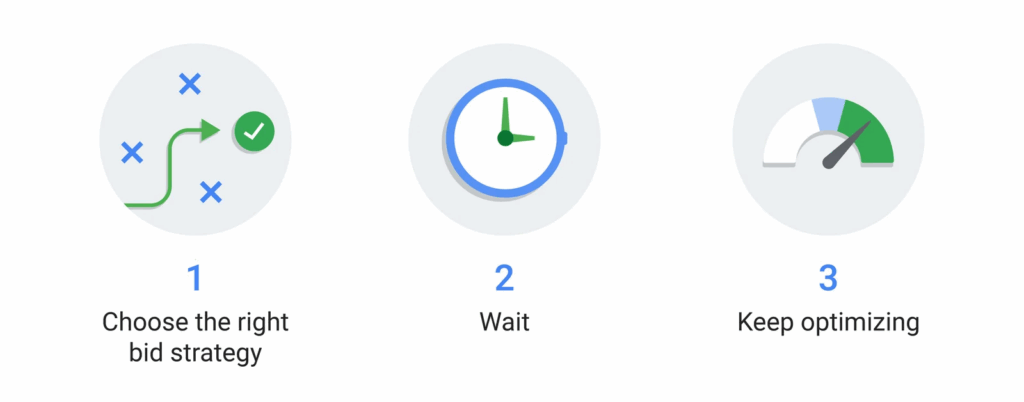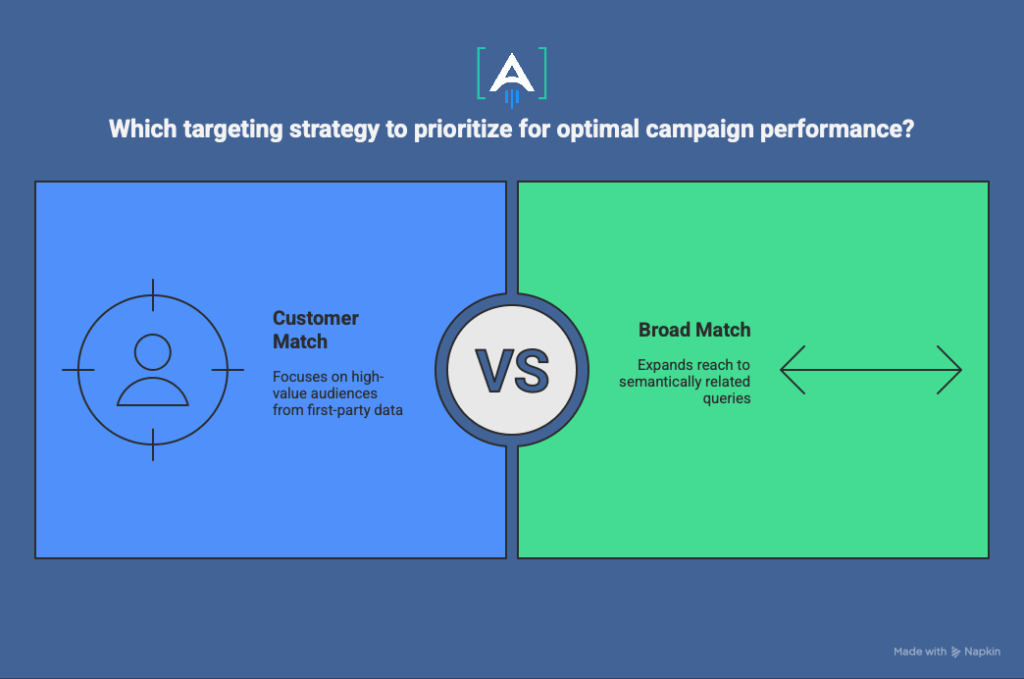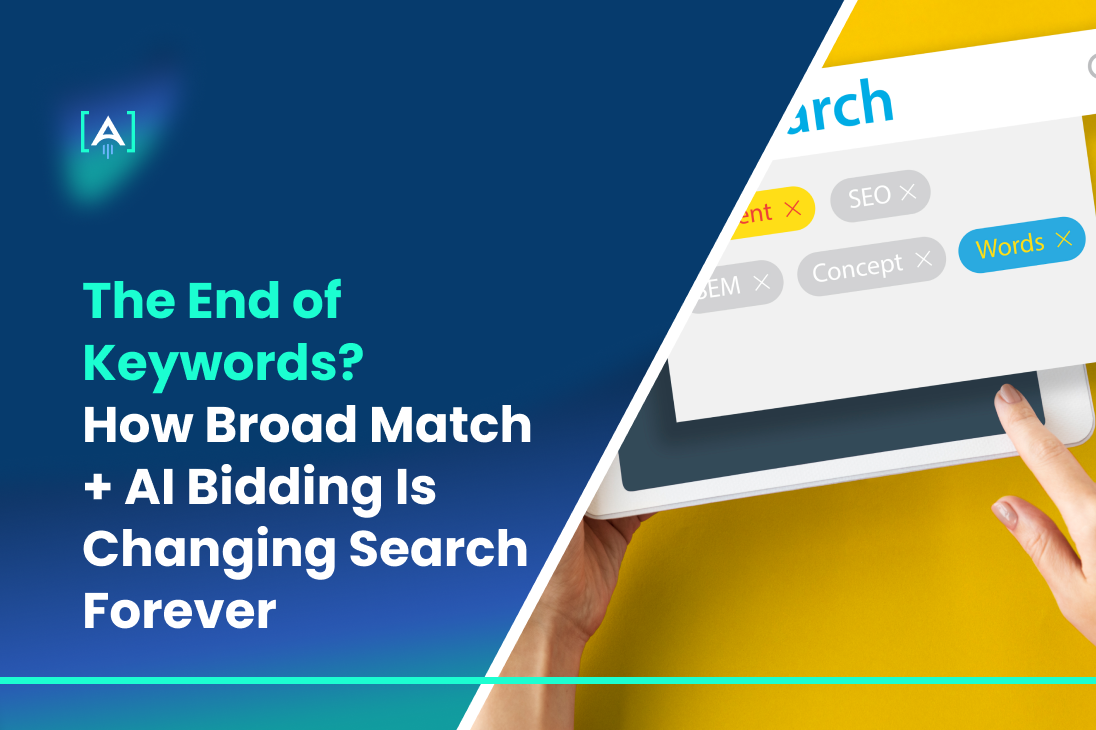In the world of search advertising, the traditional reliance on specific keywords is undergoing a profound transformation as broad match becomes central to modern campaign performance. Google Ads’ early success was built on precise keyword targeting, where advertisers meticulously selected exact and phrase match types to reach potential customers.
Campaigns were structured around manually curated keyword lists, requiring constant monitoring, bid adjustments, and optimization to ensure relevance. While effective, this approach demanded significant resources and expertise.
Over the years, user search behavior has evolved. Consumers now use natural language, ask nuanced questions, and rely on devices that interpret context rather than exact phrasing. At the same time, machine learning and AI-powered advertising have reshaped campaign execution.
Algorithms can analyze massive datasets, historical performance, and real-time signals to determine which search queries are most likely to convert.
AI bidding strategies, predictive bidding, and real-time optimization allow campaigns to adjust automatically, freeing advertisers from micromanaging every keyword.
This shift from rigid keyword lists to AI-driven intent recognition signals a new era in search marketing, one in which understanding the meaning behind queries matters more than the exact words typed. Broad match strategy combined with Smart Bidding Google Ads, automated bidding, and algorithmic optimization enables advertisers to capture intent, expand reach, and maximize ROI.
The future of search is not about controlling every keyword but about leveraging audience signals, behavioral targeting, and first-party data advertising to deliver highly relevant experiences. By focusing on context, semantics, and predictive models, advertisers can connect with the right users at the right moment, turning clicks into conversions more efficiently than ever before.
The Evolution of Keyword Targeting in Google Ads
Keyword targeting in Google Ads has evolved significantly over the past decade. Initially, advertisers relied heavily on exact match keywords to capture highly specific search queries. As campaigns scaled, phrase match and broad match types were introduced to expand reach, albeit at the cost of some relevance. Broadmatch initially carried a reputation for inefficiency, as it could trigger irrelevant clicks if not carefully monitored. Over time, however, Google has introduced automation, machine learning bidding, and algorithmic optimization that make broad match a powerful tool for intent-based targeting.
The evolution from manual keyword management to automated campaigns reflects broader trends in digital advertising. Google Ads automation now uses audience signals, behavioral targeting, predictive bidding, and real-time optimization to determine which users are most likely to convert. Advertisers no longer need to micromanage hundreds of keywords, ad groups, or match types. Instead, they feed high-quality first-party data into the system, and AI handles optimization at scale. This shift marks a fundamental change: campaigns are now judged on performance outcomes rather than keyword coverage.
What Is Broad Match and How Does It Work Today
Broad match strategy has evolved dramatically with AI integration. In 2025, broad match does more than identify synonyms or related phrases; it evaluates the context, semantics, and intent behind a user’s query.
Google Ads uses signals such as location, device, search history, and engagement patterns to determine whether an ad is relevant to a specific user. This allows campaigns targeting a phrase like “eco-friendly shoes” to appear for searches such as “best sustainable sneakers,” “recycled material running shoes,” or “green running shoes for beginners.”
The advanced semantic matching and query expansion capabilities of modern broad match enable advertisers to reach highly relevant audiences without manually creating exhaustive keyword lists.
Combining broad match with Smart Bidding in Google Ads ensures that the campaign dynamically adjusts bids based on predicted conversion value, giving brands the ability to scale efficiently while minimizing wasted spend. Broad match strategy today is less about casting a wide net indiscriminately and more about allowing AI to predict intent and surface high-value search traffic.
The AI Difference: How Smart Bidding Changed Everything
AI bidding strategies have fundamentally changed the search marketing landscape. Google Ads��’ Smart Bidding uses machine learning to evaluate millions of signals in real time, including device type, location, time of day, audience characteristics, and historical performance metrics.
This predictive bidding approach allows advertisers to set target outcomes, such as maximizing conversions, targeting a specific cost per acquisition, or optimizing for return on ad spend.
When paired with a broad match strategy, AI bidding enables performance-driven automation.
For example, a retail brand that previously relied on manual CPC and exact match keywords may find that switching to broad match with Happy Socks increases conversions by 30% while maintaining efficiency.

The system evaluates every impression and adjusts bids dynamically to maximize the likelihood of a valuable action. This combination of broad match and AI-powered advertising is now central to competitive search campaigns, particularly as audiences become more diverse and search behaviors increasingly complex.
25% Higher Delivery: The Broad Match Performance Data
Real-world data demonstrates the power of modern broad match campaigns. Google internal reports show that advertisers using a broad match strategy in combination with Smart Bidding experienced a 25% increase in conversion rates compared to similar campaigns using exact match with manual bidding.
Additionally, broad match campaigns reduced cost-per-acquisition. This usually leads to a lower CPA, allowing brands to reach new audiences without increasing budgets. Independent research by Adalysis confirmed these trends, finding that across 16,825 search campaigns, broad match paired with automated bidding consistently outperformed more restrictive keyword strategies in both conversion rate and revenue per click.
These results emphasize that automation and intent-based targeting are no longer optional; they are essential for maximizing ROI.
Audience Signals: The Secret Ingredient
The key differentiator in 2025 is not just broad match or AI bidding, but the data feeding these systems. Audience signals Google Ads collects from first-party data, website engagement, and customer behavior provide the context necessary for predictive bidding and semantic matching. Signals such as past searches, audience demographics, and purchase history enable machine learning to prioritize high-value impressions.
Campaigns that neglect to feed rich first-party data into the system may fail to reach their ideal audiences or may overpay for lower-value clicks.
Integrating first-party data advertising with broad match campaigns strengthens predictive models and ensures that ads are delivered to users most likely to convert. Customer Match targeting allows advertisers to upload high-quality lists of existing customers, enabling AI to find similar audiences.
When combined with behavioral targeting, query expansion, and real-time optimization, these audience signals create a sophisticated feedback loop that continually improves campaign efficiency.
Customer Match + Broad Match: The Power Combo

Combining Customer Match targeting with a broad match strategy is particularly effective. Customer Match enables the system to recognize high-value audiences from first-party data, while broad match expands the campaign’s reach to semantically related search queries.
This dual approach allows advertisers to scale without sacrificing relevance, finding new customers who exhibit similar behaviors and intent to their best existing users.
Brands that have implemented this combination report not only higher conversions but also stronger new-to-brand acquisition rates, proving that algorithmic optimization can outperform manual keyword management when properly executed.
Migration Framework: From Exact to Broad Without Disaster
Transitioning from exact match-heavy campaigns to a broad match requires careful planning. Start by duplicating high-performing exact match campaigns and introducing broad match keywords for testing.
Apply Smart Bidding Google Ads strategies like Maximize Conversions or Target CPA to optimize automatically. Incorporate negative keywords to filter out irrelevant traffic, ensuring the AI model learns from high-quality conversions rather than noise.
Weekly review of search terms allows advertisers to scale successful queries and pause underperforming ones. By gradually shifting campaigns, advertisers can preserve control while taking full advantage of machine learning bidding and automated PPC management.
Monitoring and Control: Preventing Runaway Spend
Even with AI automation, monitoring remains essential.
Predictive bidding and algorithmic optimization work best when campaign goals, conversion tracking, and budget limits are clearly defined. Implementing dashboards that visualize audience layering, spend by campaign, conversion rate, and ROI allows teams to spot anomalies quickly.
Budget modeling scenarios can simulate the potential impact of expanding broad match keywords, while performance comparison charts help measure progress relative to historical exact match performance.
Risk mitigation strategies such as negative keyword lists, pacing controls, and audience exclusions ensure campaigns remain efficient and avoid costly mistakes.
First-Party Data Strategy for 2025
First‑party data advertising is now the backbone of modern search campaigns. By supplying platforms like Google Ads with high‑quality data—sourced from CRM systems, customer surveys, website interactions, and transaction history—advertisers can significantly enhance predictive bidding, semantic matching, and intent‑based targeting accuracy. For example, research from The Behavioural Architects in collaboration with Google found that layering first‑party data helped challenger brands capture up to 43% of share‑of‑preference over their established competitors.

In 2025, the most advanced advertisers will activate first‑party data through four key pathways:
- Unified Data Infrastructure: Centralize CRM data, web and app analytics, loyalty program outputs, and offline purchase information in a customer data platform (CDP) to maintain clean, consented profiles.
- Audience Signals Integration: Feed conversion data, Customer Match targeting lists, and website‑behavior segments into Google Ads to improve audience precision and “look‑alike” signal activation.
- Semantic & Intent Modeling: Use intent‑based targeting to move beyond keywords—leveraging machine learning to interpret meaning, context, and user behavior rather than individual words.
- Performance Automation: Align broad match strategy, Smart Bidding Google Ads, and automated bidding frameworks with first‑party data inputs to continuously optimise for high‑value conversions rather than simply clicks.
When applied strategically, first‑party data allows automated bidding systems to learn faster, reach more relevant users, and maximise value over time. Brands that embed this data‑first approach alongside a broad match strategy and AI‑powered advertising will maintain an edge in search campaign optimisation, audience layering, and search campaign growth.
Performance Max: When to Use It
While broad match and Smart Bidding excel in search-specific campaigns, the Performance Max strategy provides a more holistic, full-funnel solution. It automates delivery across Search, Display, YouTube, Gmail, and Discover.
Brands with extensive creative assets and multiple conversion objectives benefit from Performance Max because it allows AI to allocate budget across channels based on predicted outcomes.
The decision framework is straightforward: if the goal is search-centric intent capture and maintaining campaign-level control, broad match is ideal; if the objective is omnichannel conversion optimization, the Performance Max strategy delivers scale and automation.
Case Studies: Brands That Made the Switch
Several early adopters of the broad match strategy combined with Smart Bidding in Google Ads have reported measurable performance improvements. These examples highlight the tangible benefits of aligning AI-powered advertising with first-party data, audience signals, and automated bidding:

- Mid-Size E-Commerce Retailer
- Implemented broad match campaigns paired with Target CPA bidding.
- Resulted in an increase in conversions.
- Achieved a reduction in cost-per-acquisition compared to previous exact match campaigns.
- Insights: Leveraging automated bidding allowed the algorithm to optimize for high-intent users across multiple variations of product-related queries.
- Technology Brand Using Customer Match Targeting

- Combined first-party CRM data with broad match campaigns.
- Using SDC can result in a 40% uplift in new-to-brand customer acquisition.
- Reduced wasted spend by filtering low-intent traffic through conversion-based bidding adjustments.
- Insights: Integrating Customer Match targeting enhances the AI model’s understanding of high-value audiences and improves predictive bidding accuracy.
- Online Subscription Service
- Transitioned from manual CPC campaigns to Smart Bidding + broad match.
- Saw 25% higher click-through rates on previously underperforming long-tail keywords.
- Improved engagement and retention metrics, as users found more relevant content.
- Insights: Broad match and semantic matching allow automated PPC management to uncover previously untapped search intent.
These case studies demonstrate that a broad match strategy combined with AI bidding strategies, automated bidding, and first-party data advertising produces tangible results, even for brands with different goals and verticals.
The common thread is leveraging the audience signals Google Ads provides, enabling intent-based targeting that maximizes reach without compromising relevance.
The Contrarian View: When to Stick with Exact Match
While AI-driven optimization and broad match strategies provide scale and efficiency, there are scenarios where exact match keywords remain critical:
- Highly Regulated Industries
- Sectors such as healthcare, finance, or legal services require precise query targeting to maintain compliance and avoid misrepresentation.
- An exact match ensures ads are triggered only for approved search terms, reducing risk.
- Niche Markets with Specific Intent
- Products or services with very specific technical terms, jargon, or unique identifiers benefit from exact match precision.
- Examples include B2B software tools, specialized machinery, or industrial chemicals.
- Brand Protection Campaigns
- Protecting trademarks or high-value branded terms may require exact match to prevent competitors from triggering ads in unrelated contexts.
Best Practices When Using Exact Match Today:
- Combine exact match campaigns with small-scale broad match experiments to identify new opportunities.
- Apply Smart Bidding to both match types for data-driven optimization.
- Monitor search terms regularly to detect low-quality traffic or emerging trends.
Even in these cases, the broader trend toward AI-powered advertising and automated bidding suggests that supplementing exact match with intent-based strategies allows brands to capture incremental value without losing control.
The Future of Search: Context, Not Keywords
The evolution of search marketing is clear: campaigns are moving away from keyword obsession toward context-driven optimization. Keywords are no longer the sole drivers of targeting; they serve as signals that feed AI-powered advertising systems.
Key trends shaping the future of search include:
- Predictive Bidding
- Algorithms analyze historical and real-time data to predict conversion likelihood, dynamically adjusting bids for maximum ROI.
- Semantic Matching and Query Expansion
- Broad match strategy now interprets meaning rather than exact terms, showing ads for relevant synonyms, related phrases, and contextually similar searches.
- Real-Time Optimization
- Machine learning bidding continuously updates campaign parameters based on device, location, time of day, and audience behavior patterns.
- Integration of First-Party Data Advertising
- Customer Match targeting and audience signals Google Ads provide allow advertisers to feed high-value data into AI models, enhancing intent-based targeting.
- Audience Layering
- Combining demographic, behavioral, and contextual insights ensures campaigns reach the most relevant users without sacrificing scale.
Advertisers who embrace a broad match strategy, Smart Bidding Google Ads, automated bidding, and predictive bidding will gain a significant competitive edge.
Brands that invest in AI-powered advertising now are better positioned to dominate search results, improve conversion rates, and reduce cost-per-acquisition in 2025 and beyond.
Conlusion
The future of search is context, not keywords. Marketers who shift from micromanaging individual keywords to leveraging signals, first-party data, and algorithmic optimization will lead the next decade of search marketing.
The landscape of search advertising in 2025 is no longer defined by strict keyword targeting but by intelligent, AI-driven systems that interpret intent and context.
Broad match strategy, Smart Bidding Google Ads, and automated bidding powered by first-party data have become essential tools for advertisers seeking efficiency, scale, and measurable performance.
Predictive bidding, semantic matching, and real-time optimization are no longer optional—they are the standard for campaigns that deliver meaningful results.
Advertisers who adapt to this new paradigm by integrating AI-powered advertising with audience signals and first-party data gain a significant competitive advantage.
Partnering with an experienced marketing agency ensures businesses can navigate this complex evolution effectively. [A] Growth Agency specializes in helping growth-minded companies implement AI-driven search strategies, optimize Google Ads campaigns, and leverage first-party data to maximize ROI.
From designing broad match frameworks to executing Smart Bidding campaigns and performance monitoring, our team provides strategic guidance and hands-on support to turn intent-driven insights into tangible growth.
Start future-proofing your search campaigns today. Partner with us to harness AI-powered advertising, automate your bidding strategies, and achieve smarter, faster, and more profitable Google Ads performance.

